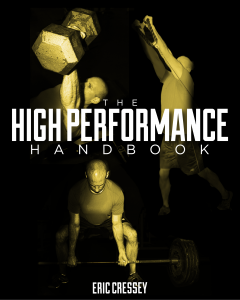6 Common Turkish Get-up Technique Mistakes
Today’s guest post on the Turkish Get-up comes from Cressey Sports Performance coach, Greg Robins.
The Turkish Get-up has gained a lot of popularity in recent years, and rightfully so, as it’s a fantastic exercise. It is also, however, a complex exercise with many different components that must be “synced up” to get the most benefits of the drill. With that in mind, I wanted to use today’s article to discuss the six most common Turkish Get-up technique mistakes I see, and how I correct them with our clients at Cressey Sports Performance.
Mistake #1: Not actively getting up.
While I didn’t sequence these in any particular order, this mistake is the most common. Too often, people roll into the start of a get-up instead creating tension and actively moving into the first position. This first movement is the definitive step in the get-up, in my opinion. If you cannot reach your forearm actively, you are either using to much load, or approaching the exercise incorrectly. Check out the video below for sign of rolling, or passive movement, and for tips on how to do it correctly.
Mistake #2: Not creating enough “space.”
One cue I use all the time when teaching the get-up is to “not let your masses move into your spaces.” In other words, if the body stays in proper alignment, you will have certain amounts of space present between your torso and your limbs / head. When we lose these spaces, you can be sure that you are beginning to rely on passive stability measures, as opposed to creating tension and actively holding positions.
Mistake #3: Rocking instead of hinging.
The transition from three points of contact to two (or from two to three, on the way back down) is common place for get-up mistakes. Mostly, people tend to rock off, or to the ground. Instead they should utilize a hip hinge pattern to shift the weight completely onto the back knee. This way they can easily lift, or place the hand back onto the ground.
Mistake #4: Keeping the joints too soft.
In some ways, this mistake could fall into the category of not creating enough space. However, I want to hone in on the importance of extension at a few joints during the movement. Often times I will see people keep these joints in slight flexion, when they should be extended. It is of note that you should also watch for people who tend to hyperextend at the elbows and knees and cue them to stay neutral, so as to promote an active form of stability. You could also apply this to the grip, which should be firm; you don’t want to see the hands open.
Mistake #5: Not engaging the anterior core.
We may have very well beat the “anti-extension” theme to death on this site. That being said, it’s a problem we see time and time again. It also happens to be very common with most folks’ Turkish Get-up technique. Make sure you are keeping the ribs down, and core braced throughout this exercise.
Mistake #6: Starting with an incorrect bottom arm position.
As with any exercise, if you don’t set up correctly, your technique will always be suboptimal. With respect to the Turkish Get-up, this is particularly important in the context of where the bottom arm is positioned at the start of the movement.
I hope these suggestions help you to improve your Turkish Get-up technique, as this is one exercise you really want to include in your strength training programs because of the many benefits it delivers. And, optimizing technique will ensure that you receive all of those benefits!
If you’re looking for how we might incorporate Turkish Get-up variations in our strength training programs, be sure to check out The High Performance Handbook, the most versatile strength and conditioning resource available today.



